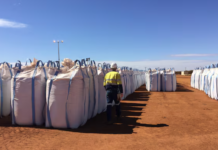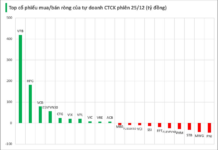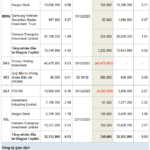Reducing Local Burden
Regarding land price tables, at the draft Law amending and supplementing a number of articles of the Land Law, the Ministry of Agriculture and Environment proposes to amend Article 159. Accordingly, the agency proposes two options.
Option 1: People’s Committee of the same level decides the land price table periodically every 5 years, announces and applies from January 1 of the first year of the period. In case it is necessary to supplement the land price table during the year, the Provincial People’s Committee will decide. The land price table is constructed according to the area and location. For areas with digital cadastral maps and land price databases, the land price table can be established up to individual land plots.
Option 2: The land price table is applied to calculate land use fees, land rent when the State allocates land, leases land, allows land use purpose conversion, recognizes land use rights, and calculates taxes and fees related to land use, performs the rights and obligations of land users, and compensates when the State recovers land. The Government will detail the cases of application of the land price table.
Thus, the land price table at the localities will be issued every 5 years and will have an annual adjustment coefficient suitable for the 5-year cycle. This is a big difference compared to the provisions of the 2024 Land Law, when the land price table is issued annually.
 The option of issuing a 5-year land price table at localities once received the consensus of experts. Photo: Hoang Ha |
Sharing with VietNamNet, economic expert Nguyen Quang Huy, CEO of Finance – Banking (Nguyen Trai University), said that the option of adjusting the land price table every 5 years with an annual adjustment coefficient is an improvement that reflects flexible thinking, harmonizing legal stability and adaptability to market fluctuations.
According to Mr. Huy, the issuance of a land price table every 5 years helps enterprises to easily make long-term plans; local authorities reduce the burden of annual updating; the policy system is consistent, minimizing legal risks.
Meanwhile, the annual adjustment coefficient helps to reflect the land price trend in each area in a timely manner, flexibly adapting to the actual socio-economic conditions, avoiding the situation of “fixed frame price, floating reality”
“However, building adjustment coefficients needs to be based on transparent market data, continuously updated, with the participation of related parties. It is necessary to publicly announce the coefficient, calculation method, and have a transparent complaint mechanism to avoid prolonged complaints,” Mr. Huy suggested.
Need to include site clearance in the amendment
Mr. Nguyen Quoc Hiep, Chairman of GP.Invest, Chairman of Vietnam Construction Contractors Association, said that amending the Land Law in the direction of separating the primary and secondary land use rights markets is a correct policy. However, in order for the law to really come into life, it is necessary to supplement some contents, especially the issue of site clearance – a big bottleneck in economic development.
According to Mr. Hiep, the establishment of a land price table prescribed by the State is a suitable principle, but the important thing is that this price table must be carefully studied and suitable to the reality.
“For the land price table to be feasible, it is necessary to have comments from experts and enterprises – those who are directly affected, to avoid overvaluation or undervaluation”, said Mr. Hiep.
He also emphasized the need to thoroughly evaluate the irrational points from Decree 71 ( stipulating land prices – PV) as well as the 2024 Land Law, thereby drawing experience to make this law amendment really effective.
One of the missing points in the draft law on amendments, according to Mr. Hiep, is the issue of site clearance, an issue that has caused congestion in many projects up to now.
“If land is a property belonging to the whole people, owned by the State, then this is an extremely valuable resource that needs to be exploited effectively. To do that, site clearance bottlenecks must be removed,” he emphasized.
According to regulations, only urban area projects are supported by the State for land recovery. However, in reality, many other economic projects also face similar difficulties but are not included in this case.
“It is necessary to expand the conditions for the State to take the initiative in land recovery. For projects where enterprises have agreed on about 70% of the area, the State will support the remaining site clearance,” Mr. Hiep proposed.
The Chairman of GP.Invest expressed his desire that when amending the Land Law, the National Assembly, the Ministry of Agriculture and Environment, should consider adding site clearance content as a specific point of amendment. “Then the law amendment will be really thorough and effective in reality,” said Mr. Hiep.
Nguyen Le
– 05:45 08/05/2025
The Hottest News: Ho Chi Minh City Implements a 3-Tier Land Pricing System
The leaders of Ho Chi Minh City’s People’s Committee have initiated the process of establishing land price tables for the first time, in accordance with the Land Law of 2024.
Proposed Land Recall if 75% Agreement with Residents is Reached
The Ministry of Agriculture and Environment has proposed a new initiative to expedite land acquisition for development projects. In a bold move, the Ministry has suggested that if investors can secure compensation agreements with at least 75% of landowners, they will be granted permission to proceed with the land retrieval process. This proposal aims to strike a balance between the needs of investors and the rights of landowners, ensuring a smooth and efficient path toward progress.
Can Agricultural Land Within Residential Areas Be Converted to Residential Land and Be Granted a New Certificate of Land-Use Rights?
Under the Land Law 2024, the conversion of land use purposes from perennial crop land to residential land falls under the category of land use changes that require authorization from competent state authorities.


